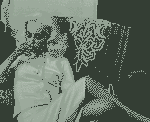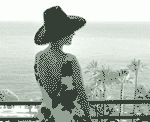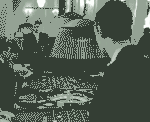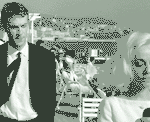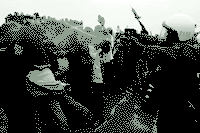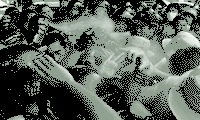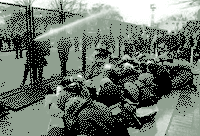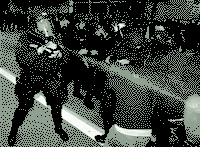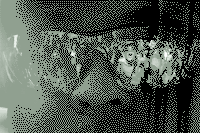August 29, 2008
Thailand demonstrators close airports and railways
Thailand sank deeper into political chaos yesterday as anti-government demonstrators forced the closure of airports and railway lines, stranding foreign and domestic passengers and increasing fears of yet another military coup.
In the capital, Bangkok, a crowd of 2,000 people faced a barrage of teargas as they attempted to take over police headquarters. In other parts of the country, members of the People’s Alliance for Democracy (PAD) demanding the resignation of Prime Minister Samak Sundaraveg shut down airports in Hat Yai and the tourist resorts of Phuket and Krabi.
“This is embarrassing in front of the world,” Mr Samak said, three days after being forced out of his office by demonstrators. “I have several tools at my disposal, but I am not using any of them because I want to keep things calm. I will not quit. If you want me out, do it by law, not by force.”
According to Thai newspaper websites, striking railway workers brought a halt to trains, and unions were urging airline and railway workers to take “sick leave” in support of the protests — the most serious political crisis since a military coup that deposed Thaksin Shinawatra, the former Prime Minister, two years ago.
The confrontation began on Tuesday when supporters of the PAD — which, despite its name, advocates an end to a democratic system — raided a state television station, government buildings and the compound containing the Prime Minister’s office. They have barricaded themselves behind razor wire and car tyres.
Their resources and the seeming reluctance of the police to act suggests that the protesters may have influential supporters in the army or the royal establishment. PAD supporters wave pictures of the King, Bhumibol Adulyadej, reading “We love the King. We love Thailand”.
“We definitely won’t leave the Government House until we can topple Samak’s administration,” the PAD leader, Sonthi Limthongkul, said. “He cannot stay on for long, I am very sure of that.”
Mr Samak was elected last December after the general election victory of his People Power Party (PPP), and made no secret of his loyalty to Mr Thaksin, the most popular, but most divisive, Prime Minister in Thailand’s history.
Mr Thaksin was deposed in the military coup in 2006 and went into exile in London, where he became proprietor of Manchester City Football Club.
This week’s demonstrations may, however, represent a last hurrah by the PAD, which has lost support among ordinary Thais for its confrontational tactics
Cyclone Zoe
The first contact has been made with people living on a remote island battered by a South Pacific cyclone which struck the Solomons group last weekend.
A New Zealand cameraman who arrived on Tikopia island by helicopter on Friday said all the island’s inhabitants appear to have survived.
“The whole way there I thought I would see hundreds of dead and festering bodies, but instead we were just overwhelmed with people running toward the plane,” cameraman Geoff Mackley told The Australian newspaper.
Mr Mackley’s report is yet to be independently confirmed, but a boat carrying relief supplies is expected to arrive at Tikopia at first light on Sunday.
There had been fears that many of the island’s population – estimated at between 1,000 and 2,000 – had perished when Cyclone Zoe hit the South Pacific last Sunday.
No information has been received from Anuta since the cyclone knocked out its radio communications.
Cyclone Zoe was one of the most powerful ever to hit the region, producing winds of up to 360 kph (225 mph).
Mr Mackley was the first to raise fears of disaster when he flew over Tikopia on 1 January, saying it would be a “miracle” if a huge number of deaths had been avoided.
But when he landed on the remote island on Friday, he said he was greeted by people rushing towards him with tales of survival.
“Every single person was alive and there they were, standing in front of me,” he said.
The islanders had apparently sheltered in mountain caves, following a centuries-old practice used by their ancestors during cyclones.
But while the death toll appears to be less than feared, the devastation caused by the cyclone is immense, Mr Mackley said.
“It looks like Hiroshima,” he told The Australian. “Whole villages have been inundated by the sea.”
The villagers told Mr Mackley how their homes and crops had been completely destroyed by waves of up to 10 metres high, and said they would need food aid for another three years.
Supplies of fresh water have also been contaminated by salt water and are only available at low tide, Mr Mackley said.
The true extent of the damage will be assessed when the first rescue boat finally reaches Tikopia and Anuta later on Saturday.
Australia and New Zealand, the two wealthiest nations in the region, have been criticised for delays in assessing the damage.
Both governments have said the sheer isolation of the two islands has hampered rescue efforts.
“How can you decide to parachute supplies in if you don’t have an assessment of what’s required,” an Australian government official said on Friday.
The two islands are part of the impoverished Solomon Islands, an archipelago 2,250 km (1,400 miles) northeast of Sydney, Australia.
Anuta
The island of Anuta is one of almost a thousand islands that make up the Melanesian nation of the Solomon Islands. Together, this group of islands cover a land mass of 28,400 square kilometres. Anuta island has been known as ‘te fatu sekeseke’, the slippery stone, due to it being such a small spot in the ocean – just half a mile in diameter and 70 miles from the next populated island, so hard to find and so easily ‘slid’ away from. Political and geographical circumstances have isolated Anuta and its Polynesian population throughout history.
The first documented sighting of Anuta was in 1791. Over the centuries, Anuta has been visited by occasional ships. Currently, a cargo ship sets sail from Honiara, the capital city of the Solomon Islands, on a round trip of the outlying islands. This is the only guaranteed contact the island has with the outside world. The cargo ship is infrequent and cannot be depended on as its course and timings are severely affected by the weather patterns that blow across the South Pacific Ocean.
It was a cargo ship that first brought Christianity to Anuta in 1916. Anglican missionaries arrived on the island, and to this day the church still operates and plays a vital part in Anutan life with church services twice a day. The church is believed to be responsible for protecting the island and its population from harm (such as epidemics, droughts and other natural disasters). Despite the strong Christian beliefs on Anuta, life is still shaped by tradition. Although the Christian God has replaced the ancient chiefs’ roles in many ways, chiefs and their close relatives maintain a sense of responsibility for the island’s spiritual welfare.
The chiefs are highly regarded on the island. Taboos exist surrounding behaviour in their presence: the Anutans think of the head as sacred and the feet profane, and therefore, physical height in rituals is important. When inside the chief’s hut, people must crawl; standing up and being higher than the chief is very badly thought of. Anutans often greet each other with a traditional Polynesian nose kiss or pikita.
When greeting the chief it is normal to press one’s nose against the chief’s knee. The chief then lifts his hand under the person’s chin and lifts their face so that both parties are pressing noses. Although Christianity has taken the place of many of Anuta’s traditional beliefs, certain practices such as this are still strictly followed.
The resident population on Anuta is just under two hundred and fifty. Although Anuta is very isolated there is a steady flow of people and objects to and from the island. On Anuta young men in particular tend to come and go by cargo ships or visiting vessels. It is not uncommon for people who visit the island to become adopted into a family and end up staying.
On Anuta, everyone is recognised as being related to everyone else. Family members are related to other family members not only by genetics but also because of certain types of social behaviour. The realities of social life in a population as small as Anuta mean that it is impossible to stick to a simple model of family relationships. A relative who is classified on the basis of social rather than genetic ties is just as much a member of his or her family group. This is important on Anuta when a visitor to the island needs to be adopted into a family and made to feel that they belong.
Concern for others is the backbone of Anutan philosophy. ‘Aropa’ is a concept for giving and sharing, roughly translated as compassion, love and affection. Aropa informs the way Anutans treat one another and it is demonstrated through the giving and sharing of material goods such as food. For example, the land on Anuta is shared among the family units so that each family can cultivate enough food to feed themselves and those around them.
The gardens on Anuta are vital sources of food for the islanders. Every family unit is responsible for the production and maintenance of their own hill top gardens. The volcanic soils grow the main staples in the Anutan diet: manioc, taro and bananas. Taro, Anuta’s most highly valued crop, is fragile and needs care and attention to ensure its growth. Manioc, on the other hand is a lot hardier, providing the Anutans with a back-up in times of storm or drought. Crop rotation is practiced on Anuta; they rarely leave fields fallow, but rotate crops so that the soil is not exhausted. This way of farming is one of the most intensive in the whole of the Pacific, as it has to support the dense population of the island.
The threat of natural disasters leaving the island with little or no food is a reality for the Anutans. They regularly bury cooked manioc or taro in what is termed a maa pit. The food, wrapped in banana leaves, is allowed to ferment in a dark and air tight environment. There are maa pits dotted around the entire island and families will share whatever they have. In 2003, Anuta was badly hit by Cyclone Zoe and much of the island’s crops were destroyed. Maa food was essential in keeping the population fed after the cyclone devastated so much of the island’s resources.
It is not just the hill top gardens that provide the Anutans with food. The sandy soils of the beach areas provide prime growing for coconut palms. The coconut has many uses on Anuta. People drink the juice and eat the flesh. It is also common to shred coconut flesh and extract the cream from it, to be used in cooking. Coconut shells are used as bowls and cups and the dried coconut husks are used for wiping dirty hands and starting fires. Coconut leaves are also used to thatch roofs and cover canoes, and they can be woven to make mats, fans and baskets.
Fruit trees such as banana and papaya are scattered all over the island and add variety to the Anutan diet, as does sugar cane which is popular with the children. The slopes of the hills are also home to breadfruit trees, a variety of palms as well as turmeric, which the Anutans use to make their ritually important dye (turmeric is also used as a spice in flavouring certain types of foods).
The land provides Anuta with a great deal of its food, but the island’s most productive source of protein is the sea. The islanders catch a variety of small reef fish close to the beach, either by communal fish drives where everyone works together to trap fish in pools in the reef system, or by snorkelling or net fishing at low tide. Tuna, wahoo, bonito, sail fish, marlin and other bigger fish are caught in deeper seas, normally on sea-going canoe trips.
Anutan fishermen know the reef system well and have a great understanding of the waves. Today, the Anutans are among some of the last Polynesians to make sea journeys in their traditional canoes using navigation techniques that have been in practice for centuries.
When travelling at night Anutans use the stars to navigate. The bow of the canoe is pointed towards a succession of stars, each star is followed when it is low in the sky and as it rises up overhead it is discarded and the course is reset by the next one in the series. It is not only the stars that are used for navigation: the clouds, the directions of the waves and the ocean swells all provide the Anutan fishermen and voyagers with important messages.
Fishermen are the only Anutans who earn money. If they catch shark, they cut off the fins and dry them. The fins are then sold to passing cargo ships or in the capital city, Honiara, when the fishermen get the opportunity to leave the island.
It is common for men to leave Anuta in the pursuit of wage labour overseas. This time away, often throughout the Solomon Islands, can range from a few months to years. Wage workers occasionally send money or goods to relatives back on Anuta, and those returning to live on the island often bring back a supply of manufactured goods.
One of the major effects of overseas contact is a dispute between the generations over health care. Anutans who have lived off the island often get a taste of western medical care, but there are no modern medical facilities when illness strikes back on the island.
In the late 1990s the chiefs on Anuta and their advisors refused to accept western medicines on the island. They argued that such a move would indicate a lack of faith in the church. It is thought by many of the Anutan elders that medicines on the island will attract more disease.
The young people of Anuta do not share all of the chiefs’ opinions, but Anuta is one of the most isolated communities on earth so change happens slowly. At the moment the island is stable and balanced both socially and environmentally. The resources are sufficient to satisfy the population, and the attitude that the Anutans share for one another, aropa, promotes co-operation and sustainability.
If this balance of life is upset the future for the island will become less certain. Epidemics, natural disasters, climate change and the encroachment of the modern world are all potential threats.
Due to its remote geographical location, Anuta’s environment, traditions and culture have been well preserved. The Anutans value their traditional practices such as travelling in their hand-carved outriggers. The island provides an abundance of crops, fish, and a high quality water source from a natural spring; Anuta has successfully supported the dense population for centuries and will hopefully continue to do so.
August 28, 2008
WWII body found hanging from tree in New Guinea
New Guinean authorities, with the help of the Australian, US and Japanese governments, are investigating the discovery of what is thought to be the skeleton of a World War II pilot.
Bush walkers discovered the skeleton hanging from a jungle canopy halfway along the 96 kilometre historic Kokoda Track, a World War II path which was used for troop movements during the battle.
The man who discovered the skeleton said it was swinging in a tree, caught up in a seat harness and was covered with moss.
The suspected remains of a WWII airman discovered in a jungle region of Papua New Guinea have turned out to be the moss-covered branches of a tree.
Hikers on the country’s Kokoda Trail found what appeared to be the remains of a parachutist tangled in wires and dangling in a tree two weeks ago.
The Australian military sent a team to investigate the “body” only to discover it was a branch tangled in vines.
An Australian Defence Force (ADF) statement said that although the location of the find was below a flight path commonly used by Allied aircraft during WWII sorties, the “remains” were in fact a moss-covered branch.
Adrift at Sea
Tual has become an ‘Island of the Damned’ for the runaway Burmese fishermen
Hundreds of “undocumented” Burmese fishermen – perhaps up to 2,000 men – have been abandoned on the remote Indonesian island of Tual, west of Papua New Guinea.
Compelled by poverty to leave their military-ruled homeland for “illegal” work in the Thai fishing fleet, the seafarers have escaped brutal working conditions and even murder on the high seas.
Some have been on Tual so long that they have married local women and have families.
Others, say reliable sources, have gone feral, scavenging the island’s forested interior and clearing smallholdings to feed themselves.
Forgotten by the world, for Burmese fishermen Tual has become an “Island of the Damned”.
August 26, 2008
August 24, 2008
Economic, social crises loom over Islands
South Pacific island nations have armies of unemployed and underemployed people who will turn to violence if its economic, social and political problems are not dealt with, a report by a Sydney-based think-tank said.
“It is only a matter of time before the growing army of unemployed and underemployed turns from restless to violent,” said a new report on the South Pacific released on Thursday, adding that the region’s poor economic development lags similar island nations like those in the Caribbean.
The report by the Centre for Independent Studies in Sydney said two million Pacific island men, or four out of five, were unemployed in towns or villages.
“These islanders are bored and frustrated. Unemployment and underemployment are at the core of the Pacific’s ‘arc of instability,’ ” it said.
The South Pacific has some of the world’s smallest and poorest countries, with economies reliant upon tourism, logging, royalties from fishing and foreign aid. The island nations of Papua New Guinea, the Solomon Islands, Vanuatu and Fiji have all suffered coups, military rebellions and civil unrest, and have been labelled an “arc of instability” by Pacific analysts.
The report titled The Bipolar Pacific”said the South Pacific was divided into nations which are developing and those failing to even supply running water and electricity in homes. Those floundering islands included Fiji, Papua New Guinea, Solomon Islands and Vanuatu, while those developing were the Cook Islands, French Polynesia, New Caledonia, Samoa and Tonga.
“Without employment-led growth, crime and corruption will worsen. Port Moresby (the capital of Papua New Guinea) has become one of the most violent cities in the world,” it said.
“With major criminal interests now operating in the region, the Pacific is developing its comparative advantage as a location for international criminal activities such as people-smuggling, drug production, and arms trafficking,” the report noted.
The danger was that about 80 per cent of the South Pacific’s population was found in the failing group of islands, where employment was rare and living standards were not rising, it said.
